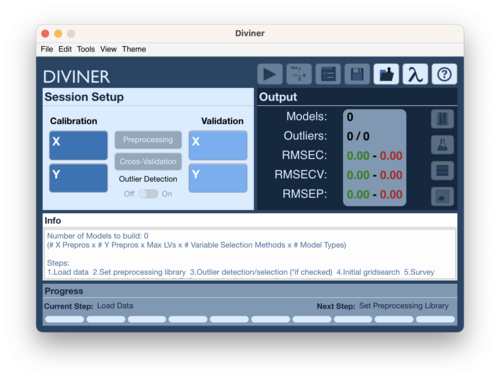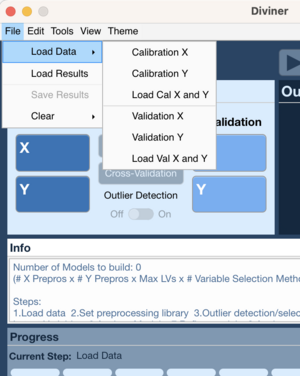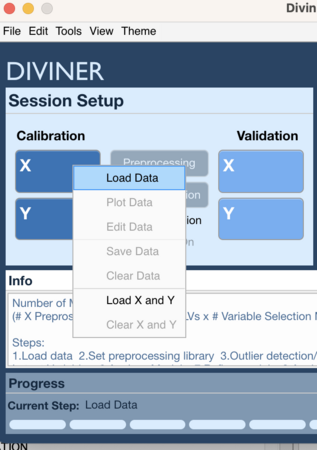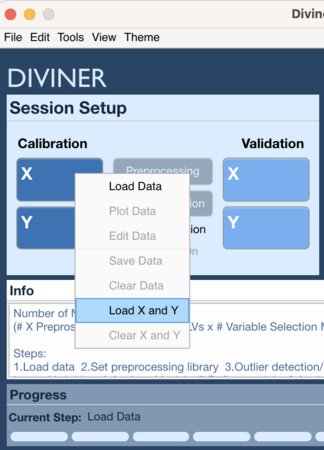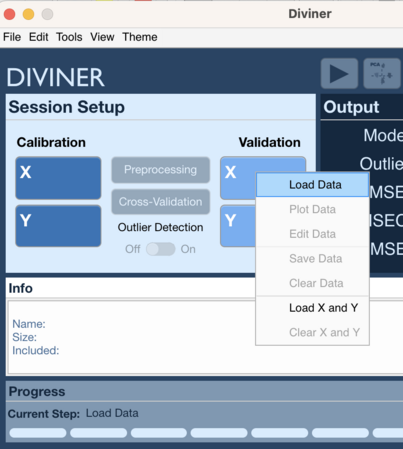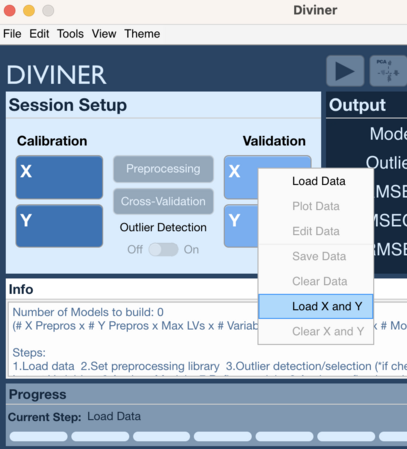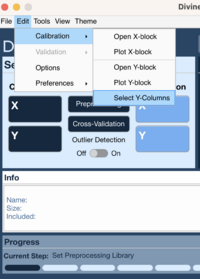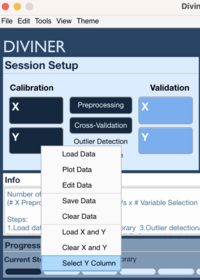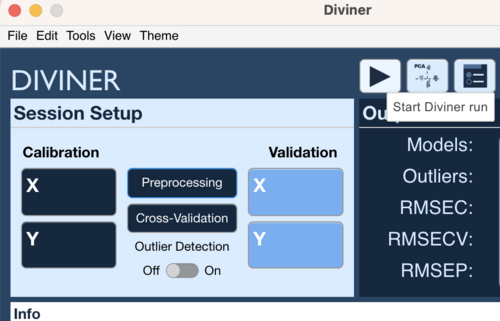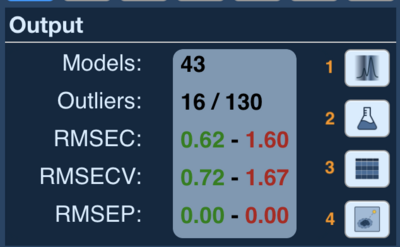Diviner analysis: Difference between revisions
No edit summary |
No edit summary |
||
| Line 67: | Line 67: | ||
</gallery> | </gallery> | ||
===Set Preprocessing Recipes=== | |||
Once data has been loaded, the next step is to set the Preprocessing recipes to be used by Diviner to build the models. Click on the Preprocessing button to open the Diviner Preprocessing window. Please see this page for more information about the Diviner Preprocessing interface: [[Diviner_preprocess | diviner preprocessing interface]]. The collection of recipes will be referred to as a library. | Once data has been loaded, the next step is to set the Preprocessing recipes to be used by Diviner to build the models. Click on the Preprocessing button to open the Diviner Preprocessing window. Please see this page for more information about the Diviner Preprocessing interface: [[Diviner_preprocess | diviner preprocessing interface]]. The collection of recipes will be referred to as a library. | ||
| Line 75: | Line 75: | ||
Review and modify the cross-validation settings using the Cross-Validation button. Please this page for more information on using cross-validation: [[Using_Cross-Validation | cross-validation]]. The default is set to Venetian Blinds with 5 splits. | Review and modify the cross-validation settings using the Cross-Validation button. Please this page for more information on using cross-validation: [[Using_Cross-Validation | cross-validation]]. The default is set to Venetian Blinds with 5 splits. | ||
===Outlier Detection=== | |||
If the preprocessing library contains recipes to use for outlier detection then sse the Outlier Detection On/Off toggle to set if Outlier detection should be performed. | If the preprocessing library contains recipes to use for outlier detection then sse the Outlier Detection On/Off toggle to set if Outlier detection should be performed. | ||
===Starting a Diviner=== | |||
To start a Diviner run, click on the '''Start Diviner Run''' button. | To start a Diviner run, click on the '''Start Diviner Run''' button. | ||
| Line 85: | Line 85: | ||
[[File:Diviner_Interface_Start_Run_button.png | 500px]] | [[File:Diviner_Interface_Start_Run_button.png | 500px]] | ||
===Review Outliers=== | |||
If outlier detection is turned on then potential outliers will need to be reviewed. Please see this page for more information: [[diviner_review_outliers | reviewing outliers for Diviner]] | If outlier detection is turned on then potential outliers will need to be reviewed. Please see this page for more information: [[diviner_review_outliers | reviewing outliers for Diviner]] | ||
=== | ===Model Refinement=== | ||
This section is under construction | '''This section is under construction''' | ||
During a Diviner run the number of models to be built is based on the number of: | |||
* X block preprocessing recipes | |||
* Y block preprocessing recipes | |||
* Model types | |||
* Variable selection methods | |||
===Review Results=== | |||
'''This section is under construction''' | |||
===Diviner Buttons=== | ===Diviner Buttons=== | ||
Revision as of 10:15, 30 August 2024
Diviner Analysis Window
The Diviner Analysis window serves as the main interface to perform a diviner run.
Using the Diviner Analysis window
Loading Data
There are several methods to load data into the Diviner analysis window. As of version 9.5 the Diviner analysis window does not allow importing data directly from a spreadsheet or other file format. This must be done before hand and the resulting DataSet Object must be present in the Workspace Browser. Please see this wiki page for importing data into: Importing Data and this webinar: Importing Data Webinar
To Load Data
File Menu 1
- Go to File → Load Data → Calibration X (or Validation X)
- Choose data to load for X block
- Go to File → Load Data → Calibration Y (or Validation Y)
- Choose data to load for Y block
File Menu 2
- Go to File → Load Data → Cal X and Y (or Val X and Y)
- Choose data for X block
- Choose data for Y block
Context Menu 1
- Right click on Calibration X block (or Validation X block)
- Select Load Data
- Choose data to load for X block
- Right click on Calibration Y block (or Validation Y block)
- Select Load Data
- Choose data to load for Y block
Context Menu 2
- Right click on Calibration X block or Calibration Y block (or Validation X block or Validation Y block)
- Select Load X and Y
- Choose data to load for X block
- Choose data to load for Y block
Validation Data
Important Note: It is recommended to load validation data, if available, before performing a Diviner run. Doing so will apply all the models to the validation data and report RMSEP values in the Diviner results. If validation data is loaded afterwards then the Diviner run will need to be recalculated to apply the models to the test data.
Select Calibration Y Column
If the Calibration Y block is multivariate then a single Y variable must be selected for modeling:
Method One
- Go to Edit → Calibration → Select Y-Column
- Select Y variable to use for modeling
Method Two
- Right click on Calibration Y block
- Choose Select Y Column
- Select Y variable to use for modeling
Set Preprocessing Recipes
Once data has been loaded, the next step is to set the Preprocessing recipes to be used by Diviner to build the models. Click on the Preprocessing button to open the Diviner Preprocessing window. Please see this page for more information about the Diviner Preprocessing interface: diviner preprocessing interface. The collection of recipes will be referred to as a library.
Cross-Validation
Review and modify the cross-validation settings using the Cross-Validation button. Please this page for more information on using cross-validation: cross-validation. The default is set to Venetian Blinds with 5 splits.
Outlier Detection
If the preprocessing library contains recipes to use for outlier detection then sse the Outlier Detection On/Off toggle to set if Outlier detection should be performed.
Starting a Diviner
To start a Diviner run, click on the Start Diviner Run button.
Review Outliers
If outlier detection is turned on then potential outliers will need to be reviewed. Please see this page for more information: reviewing outliers for Diviner
Model Refinement
This section is under construction
During a Diviner run the number of models to be built is based on the number of:
- X block preprocessing recipes
- Y block preprocessing recipes
- Model types
- Variable selection methods
Review Results
This section is under construction
Diviner Buttons
Toolbar Buttons
- Start Diviner - start a Diviner run. Becomes enabled once calibration data has been loaded and preprocessing recipes set.
- Send to PCA - quickly send data to PCA Analysis window to allow building a PCA model
- Options - open the Diviner options interface
- Save Results - save the results from a Diviner run. Becomes enabled after a Diviner run has completed.
- Load Results - load results from a Diviner run. Will clear any current results and data.
- Open Browser - open the Workspace Browser window
- Help - open Diviner documentation
Output Buttons
- Variable Consensus - open the variable consensus plot
- Results plot - open the results plot and preprocessing lookup table
- Results table - open the results table
- Outlier plot - open the outlier plot. This button will only be enabled if outlier detection was turned on.
This page is under construction
